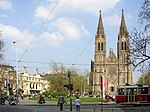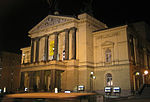Vinohrady Theatre
Art Nouveau architecture in PragueCommons category link is locally definedCzech building and structure stubsEuropean theatre (structure) stubsTheatres in Prague

Vinohrady Theatre (Czech: Divadlo na Vinohradech) is a theatre in Vinohrady, Prague. Construction began on February 27, 1905. It served as the Theatre of the Czechoslovak Army from autumn 1950 to January 1966. It contains a curtain painted by Vladimír Županský depicting a naked muse.Playwrights associated with the theatre include Viktor Dyk who was active around 1915.During the Velvet Revolution, where the Czechoslovak Socialist Republic was overthrown, there was a rally outside the theatre on the night of November 19–20; actress Vlasta Chramostová was quoted as asking the crowd: "If not now, when? If not us, then who?"
Excerpt from the Wikipedia article Vinohrady Theatre (License: CC BY-SA 3.0, Authors, Images).Vinohrady Theatre
Šubertova, Prague Vinohrady
Geographical coordinates (GPS) Address Phone number Website External links Nearby Places Show on map
Geographical coordinates (GPS)
| Latitude | Longitude |
|---|---|
| N 50.076388888889 ° | E 14.437222222222 ° |
Address
Divadlo na Vinohradech
Šubertova
120 00 Prague, Vinohrady
Prague, Czechia
Open on Google Maps








